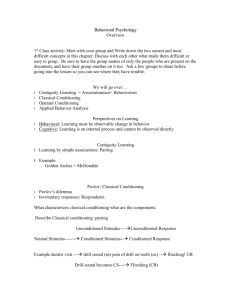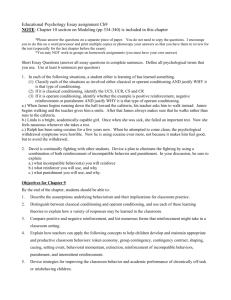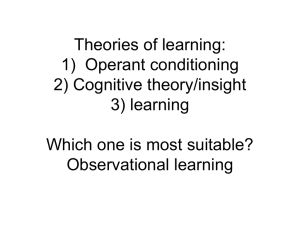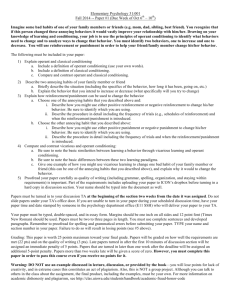LEARNING - IWS2.collin.edu
advertisement
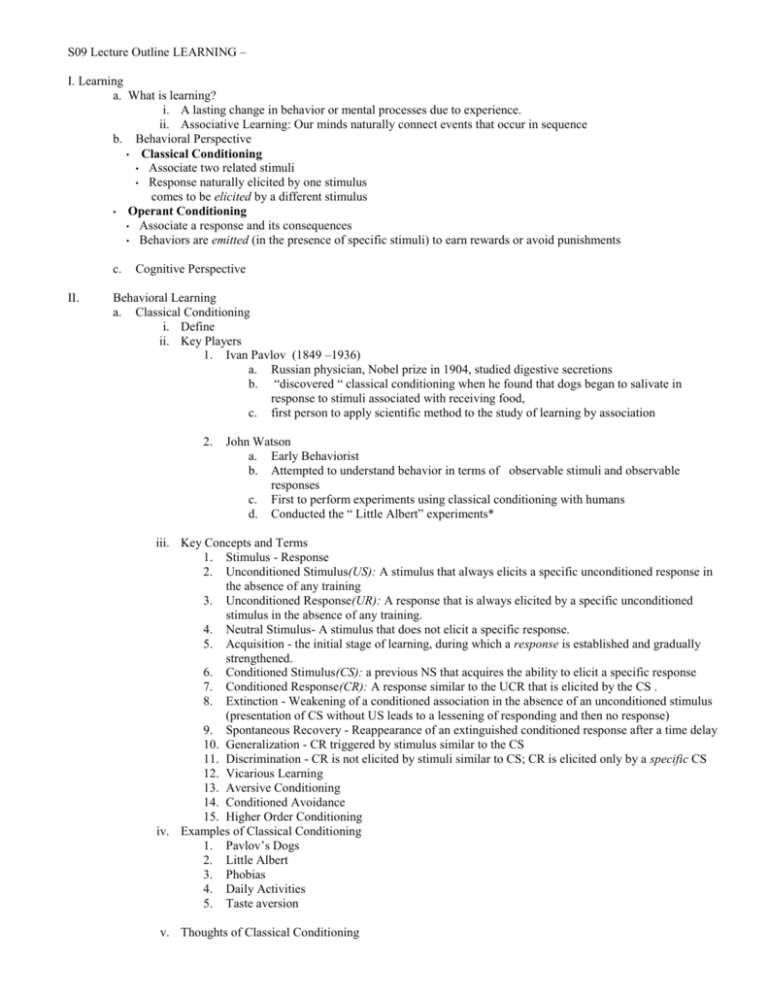
S09 Lecture Outline LEARNING – I. Learning a. What is learning? i. A lasting change in behavior or mental processes due to experience. ii. Associative Learning: Our minds naturally connect events that occur in sequence b. Behavioral Perspective • Classical Conditioning • Associate two related stimuli • Response naturally elicited by one stimulus comes to be elicited by a different stimulus • Operant Conditioning • Associate a response and its consequences • Behaviors are emitted (in the presence of specific stimuli) to earn rewards or avoid punishments c. II. Cognitive Perspective Behavioral Learning a. Classical Conditioning i. Define ii. Key Players 1. Ivan Pavlov (1849 –1936) a. Russian physician, Nobel prize in 1904, studied digestive secretions b. “discovered “ classical conditioning when he found that dogs began to salivate in response to stimuli associated with receiving food, c. first person to apply scientific method to the study of learning by association 2. John Watson a. Early Behaviorist b. Attempted to understand behavior in terms of observable stimuli and observable responses c. First to perform experiments using classical conditioning with humans d. Conducted the “ Little Albert” experiments* iii. Key Concepts and Terms 1. Stimulus - Response 2. Unconditioned Stimulus(US): A stimulus that always elicits a specific unconditioned response in the absence of any training 3. Unconditioned Response(UR): A response that is always elicited by a specific unconditioned stimulus in the absence of any training. 4. Neutral Stimulus- A stimulus that does not elicit a specific response. 5. Acquisition - the initial stage of learning, during which a response is established and gradually strengthened. 6. Conditioned Stimulus(CS): a previous NS that acquires the ability to elicit a specific response 7. Conditioned Response(CR): A response similar to the UCR that is elicited by the CS . 8. Extinction - Weakening of a conditioned association in the absence of an unconditioned stimulus (presentation of CS without US leads to a lessening of responding and then no response) 9. Spontaneous Recovery - Reappearance of an extinguished conditioned response after a time delay 10. Generalization - CR triggered by stimulus similar to the CS 11. Discrimination - CR is not elicited by stimuli similar to CS; CR is elicited only by a specific CS 12. Vicarious Learning 13. Aversive Conditioning 14. Conditioned Avoidance 15. Higher Order Conditioning iv. Examples of Classical Conditioning 1. Pavlov’s Dogs 2. Little Albert 3. Phobias 4. Daily Activities 5. Taste aversion v. Thoughts of Classical Conditioning • Pavlov and Watson underestimated importance of cognitive processes (thoughts, expectancies, perceptions) Biological predispositions -constrain ability to learn particular associations Evolutionary history- Conditioning may serve a function of survival and reproduction ---by responding to cues that help gain food, avoid danger, defeat rivals, locate mates, etc. vi. Group Exercise - Elements of Classical Conditioning • • b. Operant Conditioning i. Define: Operant behavior produces consequences Behavior is strengthened if followed by reinforcement or diminished if followed by punishment ii. Key Players 1. Edward Thorndike and the “Law of Effect” 2. B.F. Skinner “Father of Operant Conditioning” a. Believed that the most powerful influences on behavior are its consequences b. Designed operant chamber to test the effects of reinforcement on behavior i. Soundproof chamber with a bar or key that an animal presses or pecks to release a food or water reward ii. Contains a device to record responses iii. Limits available responses thus increases likelihood that the desired response will occur. c. Explored the effects of reinforcement on learning, including the effects of primary and secondary reinforcers, immediate and delayed reinforcers and various reinforcement schedules iii. Key Concepts and Terms 1. Operant behavior– complex or voluntary behaviors that produce consequences 2. Reinforcer - An event or stimulus that makes the behavior it follows more likely to occur again 3. Positive Reinforcement -A pleasant event that follows an operant response and increases the likelihood that the response will recur 4. Shaping - Reinforcing behavior that successively approximates a desired goal behavior. Shaping works by gradually guiding behavior toward the desired goal 5. Successive approximations of goal behavior - Starting with existing behavior, reward behaviors that increasingly resemble desired behavior 6. Negative Reinforcement - strengthens a given response by removing aversive stimuli. 7. Avoidance Training- Learning a desirable behavior to prevent the occurrence of something unpleasant. iv. Types of Reinforcers 1. Primary Reinforcer- A reinforcer that is rewarding in itself, such as food, water, and sex that have an innate basis because of their biological value to an organism. 2. Secondary Reinforcer -A reinforcer that acquires its reinforcing power through association with a primary reinforcer a. b. c. Developing Reinforcer Preferences Token economy The Premack Principle – Preferred activity reinforces less preferred activity v. Punishment An aversive stimulus (event) that decreases the likelihood that an ongoing behavior will recur. How does this punishment differ from negative reinforcement? Reinforcers increase the rate of responding. Punishers decrease the rate of responding 1. Positive Punishment 2. Negative Punishment 3. Problems with Punishment 4. Punishment as last resort a. For punishment to be effective it should be swift, sufficient, and certain (consistent). b. Punishment is generally not as effective as the skillful application of reinforcement. Group Exercise – Reinforcement or Punishment? vi. Contingencies of Reinforcement 1. Continuous Reinforcement- each correct response is reinforced *learning occurs rapidly, extinction occurs rapidly 2. Intermittent or Partial Reinforcement – reinforcement does not follow every response -most effective way to maintain behaviors that have already been learned * slower acquisition, greater resistance to extinction a. Schedules of Reinforcement i. Ratio Schedules – delivery of reinforcement depends on the number of responses 1. Fixed Ratio Schedule 2. Variable Ratio Schedule ii. Interval Schedules- delivery of reinforcement depends on the passage of time. 1. Fixed Interval Schedule 2. Variable Interval Schedule Fixed: the required sequence of responses is unchanging Variable: required sequence of responses changes b. Fixed Ratio Reinforced after a fixed number of responses Faster response =more rewards Example: being paid for producing a specific number of items (as in a factory setting) Brief pause in behavior that returns to very high rate of responding Variable-ratio schedule: Reinforced after unpredictable number of responses very hard to extinguish because of unpredictability Examples: playing a slot machine, fishing, sales Fixed-interval schedule Reinforced first response after fixed time period Choppy start/stop responding Rapid responding at time for reinforcement Example: receiving a salary paycheck every two weeks Variable-interval schedule Reinforced first response after variable time period Produces slow steady responding Example: surprise quizzes Group Exercise or worksheet - Schedules of Reinforcement c. Contrasts and Combinations of Classical and Operant Conditioning i. Group Exercise or worksheet d. Other •Biological predisposition - we best learn behaviors similar to our natural behaviors, unnatural behaviors instinctively drift back toward natural ones. •Overjustification Effect -A person may see a reward, rather than intrinsic interest, as the motivation for performing the task. This is known as the overjustification effect. •Self reinfocment of behavior III. IV. Cognitive Learning - learning that depends on mental processes that are not directly observable a. Social or Observational Learning Form of cognitive learning in which new responses are acquired after watching others’ behavior and the consequences of their behavior b. Cognitive Maps A mental representation of physical space that may be called on to solve problems when stimuli in the environment change c. Insight Learning Occurs rapidly as a result of understanding all the elements of a problem. Problem solving occurs by means of a sudden reorganization of perceptions d. Cognitive-Behavioral Learning Biological Mechanisms in learning i. Long-term potentiation – Biological process involving physical changes that strengthen the synapses in groups of nerve cells; believed to be the neural basis of learning





